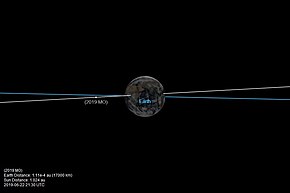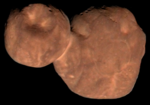 Orbital diagram of 2019 MO on 22 June 2019 Orbital diagram of 2019 MO on 22 June 2019 | |
| Discovery | |
|---|---|
| Discovered by | ATLAS–MLO (T08) |
| Discovery site | Mauna Loa Obs. |
| Discovery date | 22 June 2019 |
| Designations | |
| MPC designation | 2019 MO |
| Alternative designations | NEOCP A10eoM1 |
| Minor planet category | NEO · Apollo Alinda |
| Orbital characteristics | |
| Epoch 22 June 2019 (JD 2458656.5) | |
| Uncertainty parameter 9 · 7 | |
| Observation arc | 2.3 h (approx.) |
| Aphelion | 4.0116 AU |
| Perihelion | 0.9384 AU |
| Semi-major axis | 2.4750 AU |
| Eccentricity | 0.6208 |
| Orbital period (sidereal) | 3.89 yr (1,422 d) |
| Mean anomaly | 352.63° |
| Mean motion | 0° 15 11.16 / day |
| Inclination | 1.5471° |
| Longitude of ascending node | 91.040° |
| Time of perihelion | 2019-Jul-21 |
| Argument of perihelion | 216.76° |
| Earth MOID | 4.54412×10 AU (67.9791 km) |
| Physical characteristics | |
| Mean diameter | 3 m |
| Absolute magnitude (H) | 29.3 |
2019 MO, temporarily designated A10eoM1, was a small, harmless 3-meter near-Earth asteroid discovered by ATLAS–MLO that impacted Earth's atmosphere on 22 June 2019 at 21:25 UT. The impact of the bolide generated a 5-kiloton-equivalent explosion off the south coast of Puerto Rico which was detected by infrasound detectors. The strewn field would be spread over the Caribbean Sea.
The Apollo asteroid was inbound approaching a late July perihelion (closest approach to the Sun) when it impacted Earth at 16.1 km/s.
Overview
The asteroid was discovered by ATLAS–MLO on 22 June 2019 and was observed four times with an observation arc of just 30 minutes, typical for ATLAS discoveries before they are followed up by other resources. With such a short observation arc, how far away (and, therefore, how large) the object is very uncertain until more data are available. Using these four observations, JPL's Scout listed the impact risk as modest, and calculated that the asteroid was about 160 meters in diameter and would pass about 36 LD (14 million km) from Earth. A fireball was however reported. When the Caribbean bolide report came in from the GOES-16 weather satellite it was possible to link the ATLAS astrometry to it. Three additional precovery observations by Pan-STARRS 2 were then located and extended the observation arc to 2.3 hours. Using all seven observations, Scout then obtained a significantly better orbit determination with an impact rating of "elevated". The updated orbit shows that the asteroid was about 1.3 LD (500,000 km) from Earth when ATLAS-MLO observed it, 12 hours before impact.
Visibility
The asteroid came to opposition 175 degrees from the Sun on 17 May 2019 when it had an apparent magnitude of 27. Such a faint apparent magnitude would require a 10-hour image to detect with the largest 8-meter class telescopes in the world. Pan-STARRS is a 1.8-meter class telescope and with 30 second images has a limiting apparent magnitude of around 22. ATLAS has a limiting apparent magnitude closer to 19. The asteroid first became brighter than apparent magnitude 23 on 19 June, when it was about 4 million km from Earth. The asteroid was detected by ATLAS when it was apparent magnitude 18.1.
Meteorites

Sun · Earth · 2019 MO
This bolide was a probable meteorite fall into waters 4.8 km deep. NEXRAD weather radar detected falling meteorites at 21:26:15 UT at 10.6 km above sea level. Signatures consistent with falling meteorites appear in a total of four radar sweeps. Meteorite falls with enough mass to generate green pixels on weather radar are very rare.
Origin
It could be an Alinda asteroid originating from the 3:1 mean-motion resonance with Jupiter. Even though 2019 MO has a geometric similarity to the June epsilon Ophiuchids and four other minor meteor showers, it could just as easily be a sporadic meteor that just looks similar by chance. 2019 MO is about 12° away from the concentration of June epsilon Ophiuchids orbits.
The few other asteroids discovered before impacting are 2008 TC3, 2014 AA, 2018 LA, 2022 EB5 and 2022 WJ1.
Notes
- With only 4 observations over a very short observation arc of 30 minutes, the first Scout solution estimated that the asteroid was bigger and further away. With an estimated absolute magnitude (H) of 21.6 and an assumed albedo of 0.15, the asteroid would have been around 160 meters in diameter.
- Magnitude 27 is 40 times fainter than magnitude 23 and magnitude 23 is 40 times fainter than magnitude 19.
See also
References
- ^ "MPEC 2019-M72 : 2019 MO". IAU Minor Planet Center. 25 June 2019. Retrieved 25 June 2019.
- ^ "2019 MO". Minor Planet Center. Retrieved 8 July 2019.
- ^ "JPL Small-Body Database Browser: (2019 MO)" (2019-06-22 last obs.). Jet Propulsion Laboratory. Retrieved 26 June 2019.
- ^ Gray, Bill. "Pseudo-MPEC for A10eoM1". Project Pluto. Archived from the original on 25 June 2019. Retrieved 25 June 2019.
- ^ Guido, Ernesto (25 June 2019). "Small Asteroid 2019 MO (NEOCP A10eoM1) impacted Earth on June 22". Comets & Asteroids news (remanzacco). Retrieved 28 December 2019.
- Mack, Eric (25 June 2019). "An asteroid hit Earth right after being spotted by telescope this week". CNET. Retrieved 29 June 2019.
- ^ Gal, Roy. "Breakthrough: UH team successfully locates incoming asteroid". University of Hawaii. Retrieved 26 June 2019.
- "2019 MO at 2019-Jun-22 21:25 UT". JPL Horizons. Retrieved 17 January 2021.
- Web archive of Scout: A10eoM1 with 4 observations
- "IAWN: 2019 MO Geometry". International Asteroid Warning Network.
- "Caribbean Sea near Puerto Rico". Astromaterials Research and Exploration Science Division (ARES@NASA). Retrieved 28 October 2020.
- Paul Roggemans (7 July 2019). "June Epsilon Ophiuchids (JEO#459), 2019 Outburst and an Impactor?". Meteor News. Archived from the original on 10 February 2022. Retrieved 8 July 2019.
External links
- 2019 MO at NeoDyS-2, Near Earth Objects—Dynamic Site
- 2019 MO at ESA–space situational awareness
- 2019 MO at the JPL Small-Body Database
| 2019 in space | ||
|---|---|---|
| Space probe launches |
|    |
| Impact events |
| |
| Selected NEOs | ||
| Exoplanets |
| |
| Discoveries |
| |
| Comets | ||
| Space exploration |
| |
| Small Solar System bodies | |||||||
|---|---|---|---|---|---|---|---|
| Minor planets |
| ||||||
| Comets | |||||||
| Other | |||||||